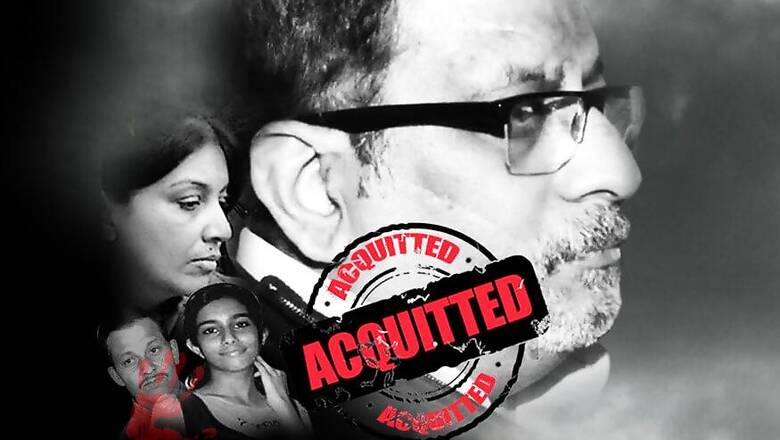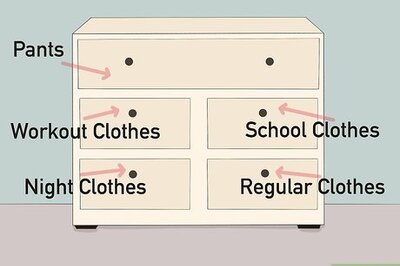
views
New Delhi: When Judge S Lal of the CBI court held Dr Rajesh and Nupur Talwar guilty of killing their 14-year-old daughter Aarushi Talwar and domestic help Hemraj, it could not be fathomed that four years later, the very basis of his verdict would be struck down by the Allahabad High Court.
In a strongly worded judgment that acquitted the Talwars, a division bench of Justice Bal Krishna Narayana and Justice AK Mishra of the HC stated that "the trial judge is supposed to be fair and transparent and should act as a man of ordinary prudence and he should not stretch his imagination to infinity — rendering the whole exercise mockery of law."
News18.com is the first to access a copy of the verdict which the two judges concurred on. The verdict was primarily written by Justice Narayana, whereas Justice Mishra gave concurring reasoning of the order later.
“The learned trial Judge has prejudged things in his own fashion, drawn conclusion by embarking on erroneous analogy conjecturing to the brim on apparent facts telling a different story propelled by vitriolic reasoning…. The learned trial Judge took evidence and the circumstances of the case for granted and tried to solve it like a mathematical puzzle…” the verdict said.
“But the point is that the learned trial judge cannot act like a maths teacher who is solving a mathematical question by analogy after taking certain figure for granted.”
“That way, the learned trial Judge has aberrated and by dint of fallacious analogy and reasoning has surprisingly assumed fictional animation of the incident as to what actually took place inside and outside the Flat L 32 Jalvayu Vihar… like a film Director, the trial Judge has tried to thrust coherence amongst facts inalienably scattered here and there but not giving any coherence to the idea as to what in fact happened.”
Justice Narayana has clearly stated that "Section 106 of the Indian Evidence Act does not relieve the prosecution to prove its case beyond all reasonable doubt."
The CBI court had in its 2013 judgment held the Talwar couple guilty of killing their 14-year-old daughter Aarushi Talwar after noting that the Evidence Act provisions had transferred the onus on the parents to explain how the teenager was murdered.
The trial court relied upon Sections 106 and 114 in the Evidence Act to state that since the Talwars were the only people in the house when Aarushi and their domestic help Hemraj were killed, they had to furnish satisfactory explanations to discharge their burden of proof.
Under Section 114, a court is entitled to "presumption of certain facts" based on certain reasonable human conduct.
However, now the Allahabad HC has stated that burden of proof can only be shifted to accused only when prosecution has proved its case.
"Only when the prosecution case has been proved, the burden in regard to such facts which was within the special knowledge of the accused may be shifted to the accused for explaining the same," reads the HC verdict.
Justice Narayana, "applying the well-settled principle of law that suspicion, however, grave may be, cannot be a substitute for proof", said that "herein prosecution has not been able to prove its case beyond all reasonable doubt”.
The Allahabad HC has clearly stated that "Graver the crime, greater should be the standard of proof."
Since the entire trial court verdict was based on circumstantial evidence, the High Court has ruled that if an evidence gives an option of benefit of doubt to the accused, then it shall be given, and thereby overturned the trial court order.
"It is well settled that the prosecution must stand or fall on its own legs and it cannot derive any strength from the weakness of the defence. An accused may appear to be guilty on the basis of suspicion but that cannot amount to legal proof. When on the evidence two possibilities are available or open, one which goes in the favour of the prosecution and the other benefits an accused, the accused is undoubtedly entitled to the benefit of doubt," said Justice Narayana in the verdict.
However, Justice Mishra has stated that it was as if the trial judge was venting his own emotion in the 2013 verdict without proper understanding of evidence and facts and had only acted out of "extra zeal and enthusiasm”.
"It is apparent that the trial Judge was unmindful of the basic tenets of law and its applicability to the given facts and circumstances of the case and failed to properly appraise facts and evaluate evidence and analyse various circumstances of this case. It can by no means be denied that the trial judge, perhaps out of extra zeal and enthusiasm and on the basis of self-perception adopted partial and parochial approach in giving vent to his own emotional belief and conviction and thus tried to give concrete shape to his own imagination stripped of just evaluation of evidence and facts of this case," wrote Justice Mishra in the verdict.
Judge Lal of the trial court in 2013 verdict had quoted the judgment of Khem Karan vs State of UP and stated that if all the circumstances and the evidence on those basis point towards the guilt of the accused and there is no possibility of any other alternative hypothesis, then only the accused can be convicted solely on the basis of circumstantial evidence.
However, the Allahabad HC has called the judge unmindful of basic tenets of law and said that his "evaluation of evidence ought to be shunned”.
"Such recalcitrant mindset in interpreting facts vis-a-vis circumstances of the case and evaluation of evidence ought to have been shunned. Trial judge should evaluate evidence in its existing form, should not tinge it with his passionate reasoning so as to give a different construction than the one which is naturally reflected and forthcoming," said the HC verdict.
The verdict also strikes down the 2013 trial court order by stating that "the entire judgment is on the whole creation of fanciful reasoning with ‘pick and choose’, presuming facts with indomitable obstinancy and taking things for granted, thus, basing conclusion on unfounded evidence."
Justice Mishra has laid down five guidelines which a trial court must keep in mind while deciding cases of such nature — the parochial and narrow approach to the facts and evidence should be avoided; passionate and rash reasoning should not be the guiding factor while scrutinising evidence; facts and circumstances of a criminal case, self-perception and realm should not be reflected on analogy of the facts; evidence on record, judgment should not be based on self-created postulates; imagination should not be given a concrete form and transparency of approach must be reflected in the judgment.

















Comments
0 comment